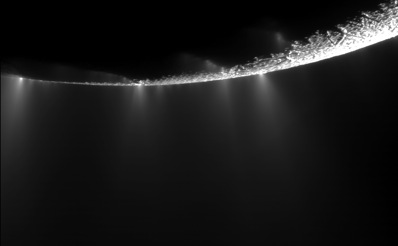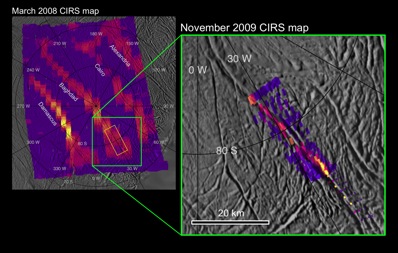
New jets spray from Enceladus
DR EMILY BALDWIN
ASTRONOMY NOW
Posted: 25 February 2010


Images captured by Cassini as it swooped past Enceladus' south polar region in November reveal a plethora of new jets and plumes spraying out from prominent fractures.
The flyby also yielded the most detailed temperature map to date of one of the fractures, and the best three-dimensional image of a tiger stripe, as well as filling in some gaps in the mapping of the south polar region. Tiger stripes dominate this region, spraying icy particles, water vapour and organic compounds out into space.
 Dramatic plumes spray water ice out into space from many locations along Enceladus' south polar fractures. More than 30 individual jets of different sizes can be seen in this image, 20 of which had not been seen before. Image: NASA/JPL/SSI. Dramatic plumes spray water ice out into space from many locations along Enceladus' south polar fractures. More than 30 individual jets of different sizes can be seen in this image, 20 of which had not been seen before. Image: NASA/JPL/SSI.
“Enceladus continues to astound,” says Bob Pappalardo, Cassini project scientist at NASA’s Jet Propulsion Laboratory. “With each Cassini flyby, we learn more about its extreme activity and what makes this strange moon tick.”
In one image mosaic alone, scientists counted more than 30 individual geysers, including more than 20 that had not been seen before, and one which seems to have reduced in strength since it was last imaged. “This last flyby confirms what we suspected,” says Carolyn Porco, imaging team lead based at the Space Science Institute in Boulder. “The vigor of individual jets can vary with time, and many jets, large and small, erupt all along the tiger stripes.”
 A detailed look at heat radiation from the fissure named Baghdad Sulcus. The heat previously detected is found to be confined to a narrow region no more than one kilometre wide, and varies in temperature along the fissure. The brightest colours do not correspond directly to the higher temperatures, but rather to a combination of higher temperatures and larger areas of warm surface material. The intensity of heat radiation increases as the colour shades from violet to red to orange to yellow. No internal heat was detected in the darkest violet regions, and uncoloured regions were not mapped by Cassini's composite infrared spectrometer. Image: NASA/JPL/GSFC/SWRI/SSI. A detailed look at heat radiation from the fissure named Baghdad Sulcus. The heat previously detected is found to be confined to a narrow region no more than one kilometre wide, and varies in temperature along the fissure. The brightest colours do not correspond directly to the higher temperatures, but rather to a combination of higher temperatures and larger areas of warm surface material. The intensity of heat radiation increases as the colour shades from violet to red to orange to yellow. No internal heat was detected in the darkest violet regions, and uncoloured regions were not mapped by Cassini's composite infrared spectrometer. Image: NASA/JPL/GSFC/SWRI/SSI.
Combing heat data with visible light images of a 40 kilometre segment of the longest tiger stripe, Baghdad Sulcus, shows the relationship between the geologically youthful surface fractures and the anomalously warm temperatures seen previously in this region. The broad swaths of heat previously detected by the infrared spectrometer appear to be confined to a narrow, intense region no more than a kilometre wide along the fracture. Temperatures peak at 180 Kelvin, most likely heated by warm upwelling water vapour that propels the jets of icy particles out of the fissures.
“The fractures are chilly by Earth standards, but they’re a cozy oasis compared to the numbing 50 Kelvin of their surroundings,” says John Spencer, a composite infrared spectrometer team member. “The huge amount of heat pouring out of the tiger stripe fractures may be enough to melt the ice underground. Results like this make Enceladus one of the most exciting places we’ve found in the Solar System.”
Some of Cassini's scientists speculate that the warmer the temperatures are at the surface, the greater the likelihood that jets erupt from liquid. If confirmed, this makes Enceladus' organic-rich subsurface the most accessible extraterrestrial ocean in the Solar System.
The 21 November flyby afforded Cassini's visible light cameras a last look at this region of the moon's south polar surface before it is plunged into 15 years of darkness.
|



